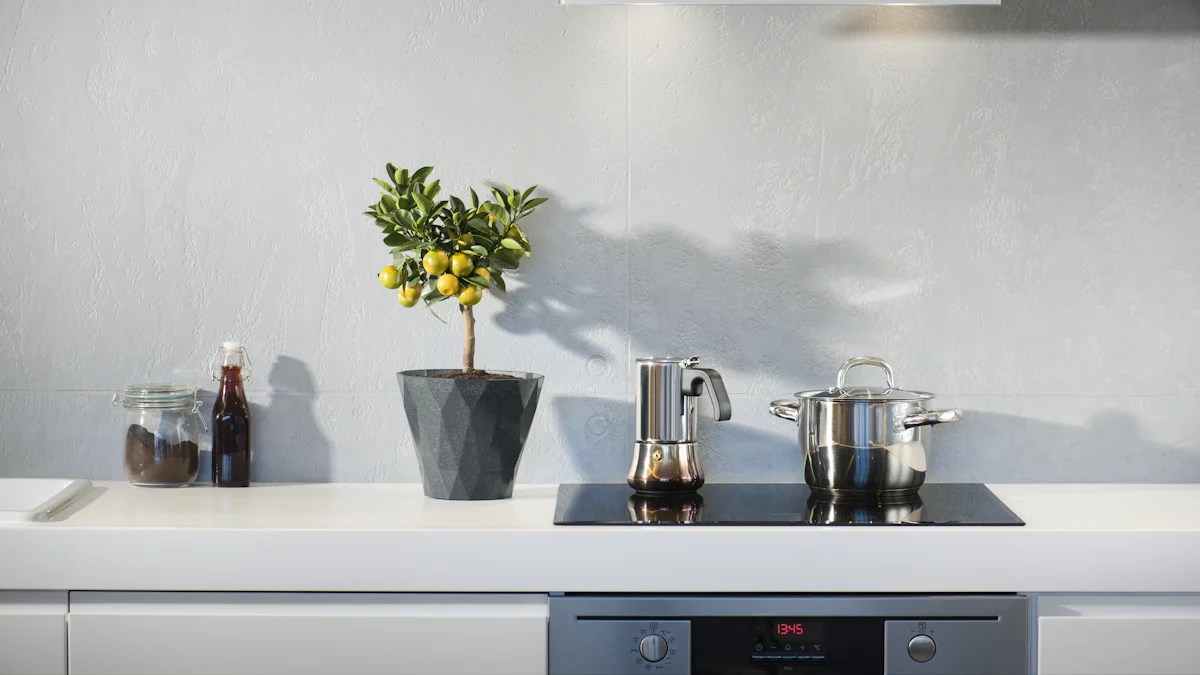Understanding How Induction Cooktops Work

Have you ever wondered how an induction cooktop works its magic? It uses electromagnetic induction to heat your pots and pans directly. This means the induction burner doesn't get hot itself; instead, it turns your cookware into the heat source. Pretty cool, right? Unlike traditional stoves, induction cooking is super efficient, using up to 90% of the energy generated. This not only speeds up cooking but also keeps your kitchen cooler. Plus, with precise temperature control, you can cook like a pro without the guesswork.
Key Takeaways
Induction cooktops use electromagnetic induction to heat cookware directly, making them highly efficient and keeping your kitchen cooler.
To enjoy the benefits of induction cooking, ensure your cookware is compatible; look for materials like cast iron, stainless steel, and carbon steel.
Induction cooking offers precise temperature control, allowing for accurate cooking without the guesswork, perfect for both novice and experienced chefs.
Safety is enhanced with induction cooktops, as the surface remains cool to the touch, reducing the risk of burns and accidents in the kitchen.
Cleaning induction cooktops is a breeze; spills don't burn onto the surface, allowing for quick and easy maintenance after cooking.
While induction cooktops can be more expensive initially, their energy efficiency can lead to long-term savings on utility bills.
Be prepared for a learning curve when switching to induction cooking, but with practice, you'll appreciate the speed and convenience it offers.
The Science Behind Induction Cooktops
Curious about the magic behind induction cooktops? Let's dive into the science that makes them tick.
Electromagnetic Induction Explained
Induction technology relies on electromagnetic induction to heat your cookware. When you turn on an induction burner, it creates a magnetic field. This field interacts with the metal in your pots and pans, causing them to heat up. Unlike traditional stoves, where the burner itself gets hot, induction cooktops transfer energy directly to the cookware. This method is not only efficient but also ensures that the surrounding area stays cool.
Role of the Induction Coil
The induction coil is the heart of the induction burner. It sits beneath the cooktop surface and generates the magnetic field. When you place a compatible pot or pan on the burner, the coil's magnetic field induces electric currents in the cookware. These currents generate heat, cooking your food. The induction coil's design allows for precise temperature control, giving you the ability to cook with accuracy and ease.
How Induction Burners Generate Heat
Induction burners generate heat through a fascinating process. Once the induction coil creates a magnetic field, it penetrates the cookware. The cookware, acting as a resistor, converts the magnetic energy into heat. This process is incredibly efficient, as nearly all the energy goes directly into heating the pot or pan. With induction cooking, you experience faster heating times and more consistent cooking results. Plus, since the burner itself doesn't heat up, induction stoves offer a safer cooking environment.
Key Components of Induction Stoves
When you explore the world of induction stoves, you'll find several key components that make them unique and efficient. Let's break down these essential parts to understand how they contribute to the magic of induction cooking.
Induction Coil
The induction coil is the powerhouse of your induction cooktop. It sits beneath the surface and generates a magnetic field when you turn on the induction burner. This coil is responsible for transferring energy directly to your cookware, making it the heart of the induction process. The coil's design allows for precise temperature control, ensuring your food cooks evenly and efficiently. With this technology, you can enjoy faster cooking times and a cooler kitchen environment.
Control Panel and Settings
The control panel is your command center for operating induction stoves. It offers a range of settings that let you adjust the heat with precision. Most induction cooktops come with digital displays, touch controls, and programmable memory functions. These features make it easy for you to set the exact temperature you need for your recipes. Some models even include delay timers and automatic shut-off options, adding an extra layer of convenience and safety to your cooking experience.
Cooktop Surface
The cooktop surface of an induction stove is sleek and modern. Made from durable materials like glass or ceramic, it remains cool to the touch during cooking. This feature not only enhances safety but also makes cleaning a breeze. Since the heat is generated directly in the cookware, spills and splatters don't burn onto the surface. You can simply wipe it clean after use. The smooth design of the cooktop also adds a stylish touch to your kitchen, complementing any decor.
With these components working together, induction cooktops offer a cooking experience that's both efficient and enjoyable. Whether you're a seasoned chef or a home cook, you'll appreciate the speed, precision, and safety that induction cooking brings to your kitchen.
Choosing Compatible Cookware for Induction Cooking

When it comes to induction cooking, selecting the right cookware is crucial. Not all pots and pans will work on an induction cooktop. You need induction-compatible cookware to make the most of this efficient cooking method. Let's explore the types of materials that work best and how you can test your existing cookware for compatibility.
Types of Cookware Materials
For induction cooking, you need cookware made from ferromagnetic materials. This means the cookware must contain iron or have a magnetic base. Here are some common materials that work well:
Cast Iron: This classic material is naturally magnetic and works perfectly with induction cooktops. Its heavy build also ensures even heat distribution.
Stainless Steel: Not all stainless steel is created equal. Look for magnetic stainless steel, which is often labeled as induction-compatible. It combines durability with efficient heating.
Carbon Steel: Similar to cast iron, carbon steel is magnetic and heats up quickly. It's a great choice for induction cooking.
Enameled Steel: This material offers the benefits of steel with a protective enamel coating, making it both functional and stylish.
Avoid cookware made entirely of glass, ceramic, aluminum, or copper, as these materials do not work with induction cooktops unless they have a magnetic layer.
How to Test Cookware Compatibility
Wondering if your current pots and pans will work on an induction cooktop? Here's a simple test you can try at home:
The Magnet Test: Grab a magnet and place it on the bottom of your cookware. If the magnet sticks firmly, your cookware is induction-compatible. If it doesn't, you'll need to find alternatives.
Check the Label: Many manufacturers label their products as "induction-compatible." Look for this label when purchasing new cookware to ensure it will work with your induction cooktop.
Consult the Manufacturer: If you're unsure about a specific piece of cookware, check the manufacturer's specifications. They often provide details about compatibility with induction stoves.
By choosing the right induction-compatible cookware, you can enjoy the full benefits of induction cooking. Whether you're using cast iron, stainless steel, or another magnetic material, you'll experience efficient heating and precise temperature control.
Benefits of Induction Cooktops
When you consider upgrading your kitchen, induction cooktops offer several compelling advantages. Let's explore the benefits that make them a top choice for modern cooking.
Energy Efficiency
Induction cooktops stand out for their remarkable energy efficiency. Unlike traditional gas or electric stoves, they heat cookware directly through electromagnetic induction. This method ensures that nearly all the energy goes into cooking your food, minimizing waste. You can expect induction cooktops to be about 84% efficient, which is significantly higher than other options. This efficiency not only saves energy but also reduces your utility bills over time.
Safety Features
Safety is a major concern in any kitchen, and induction cooktops excel in this area. The induction burner itself doesn't get hot; instead, it heats the cookware directly. This means the cooktop surface remains cool to the touch, reducing the risk of burns. Additionally, many induction cooktops come with built-in safety features like automatic shut-off and child locks. These features provide peace of mind, especially if you have young children at home.
Ease of Cleaning
Cleaning up after cooking can be a hassle, but induction cooktops make it easier. Since the cooktop surface stays cool, spills and splatters don't burn onto it. You can simply wipe the surface clean with a damp cloth. The smooth, flat design of induction cooktops also means there are no crevices for food to get stuck in. This ease of cleaning saves you time and effort, allowing you to enjoy your meals without worrying about a lengthy cleanup process.
With these benefits, induction cooktops offer a modern, efficient, and safe cooking experience. Whether you're drawn to their energy efficiency, safety features, or ease of cleaning, you'll find that induction cooktops enhance your kitchen in multiple ways.
Potential Drawbacks of Induction Cooktops
While induction cooktops offer many benefits, they also come with some challenges. Understanding these potential drawbacks can help you make an informed decision.
Learning Curve for New Users
Switching to induction cooking might feel like learning a new skill. You might find that the heating element sometimes cuts off prematurely or shuts off without warning. This can be frustrating, especially if you're used to the steady heat of gas or electric stoves. The control panel can also be tricky. If the buttons don't respond, it won't perform its primary function, leaving you puzzled. But don't worry! With a bit of practice and patience, you'll get the hang of it.
Noise During Operation
Induction burners can be a bit noisy. You might hear a humming or buzzing sound during operation. This noise comes from the fan inside the cooktop, which helps keep the electronics cool. Some people find this sound distracting, especially in a quiet kitchen. However, it's a small trade-off for the efficiency and speed that induction cooking offers.
Cost Considerations
Induction cooktops can be more expensive than traditional stoves. The initial investment might seem steep, especially if you need to buy new cookware. Induction-compatible pots and pans are essential, and they can add to the overall cost. Additionally, if you have a pacemaker, you should consult your doctor before using an induction cooktop, as the electromagnetic fields might pose a risk. Despite these costs, many users find the long-term energy savings and cooking benefits worth the price.
Safety Tips for Using Induction Cooktops
When using induction cooktops, safety should always be a priority. Here are some practical tips to ensure you use your cooktop safely and effectively.
Safe Use Practices
Use Compatible Cookware: Always use cookware that is compatible with induction cooktops. Look for pots and pans labeled as "induction safe." You can also perform the magnet test: if a magnet sticks to the bottom of your cookware, it's suitable for induction cooking.
Avoid Scratching the Surface: Induction cooktops can scratch easily. To prevent this, use cookware with clean, smooth bottoms. Avoid sliding pots and pans across the surface. Instead, lift them when moving. Also, refrain from using sharp tools or abrasive cleaning materials on the cooktop.
Keep the Cooktop Clean: Regularly clean your induction cooktop to maintain its efficiency and appearance. Wipe spills immediately with a soft cloth. For stubborn stains, use a non-abrasive cleaner. Keeping the surface clean prevents food from burning onto the cooktop, making it easier to maintain.
Monitor Cooking Times: Induction cooktops heat quickly, so keep an eye on your cooking times to prevent overcooking or burning. Use the timer function if your cooktop has one, to help manage cooking durations.
Be Mindful of Heat: Although the cooktop surface remains cool, the cookware itself can get very hot. Use oven mitts or pot holders when handling hot pots and pans to avoid burns.
Maintenance and Care
Regular Inspections: Periodically check your induction cooktop for any signs of damage or wear. Look for cracks or chips on the surface, and ensure the control panel functions properly. Address any issues promptly to prevent further damage.
Proper Storage: Store your induction-compatible cookware properly to avoid damaging the cooktop surface. Stack pots and pans carefully, and use protective liners if necessary to prevent scratches.
Follow Manufacturer's Instructions: Always refer to the manufacturer's instructions for specific maintenance guidelines. Each model may have unique care requirements, so it's essential to follow these recommendations to prolong the lifespan of your cooktop.
Professional Servicing: If you encounter any technical issues with your induction cooktop, seek professional servicing. Attempting to fix complex problems yourself can lead to further damage or void warranties.
By following these safety tips and maintenance practices, you can enjoy the benefits of induction cooking while ensuring a safe and efficient kitchen environment.
Understanding how induction cooktops work can transform your cooking experience. These cooktops heat cookware directly, offering precise temperature control and faster cooking times. You enjoy energy efficiency and a cooler kitchen environment. However, consider the initial cost and the need for compatible cookware. If you're ready to embrace modern cooking technology, working with induction cooktops could be a game-changer in your culinary adventures. They provide a blend of speed, safety, and ease of cleaning that traditional stoves can't match.
FAQ
How does an induction cooktop work?
Induction cooktops use a fascinating process called electromagnetic induction. When you turn on the induction hob, it passes an electric current through a coil beneath the surface. This creates a magnetic field that interacts with your cookware, generating heat directly in the pan. The cooktop itself stays cool, making it safe and easy to clean.
Can induction cookware be used on other types of stoves or cooktops?
Yes, you can use induction-compatible cookware on other types of stoves, like gas or electric. However, the reverse isn't always true. Not all cookware works on an induction hob. You need pots and pans with a magnetic base for induction cooking.
What are the benefits of induction cooktops?
Induction hobs offer several advantages. They heat up quickly and use energy efficiently, which can save you time and money. You also get precise temperature control, allowing you to cook with accuracy. Plus, the cooktop surface remains cool, reducing the risk of burns and making cleanup a breeze.
What are the downsides to induction cooktops?
While induction hobs have many benefits, they do have some drawbacks. You might notice a slight noise from the cooling fan during operation. Additionally, they can interfere with pacemakers due to radio-frequency emissions. It's also important to consider the cost, as induction cooktops and compatible cookware can be more expensive.
Is induction cooking safe?
Absolutely! Induction cooking is one of the safest methods available. The heat generates within the cookware itself, so the cooktop surface stays much cooler than traditional stoves. There's no open flame, which reduces the risk of fire and eliminates the possibility of gas leaks.
What are the specific requirements for cookware when using an induction cooktop?
For induction cooking, you need cookware with iron particles in the base. This includes materials like cast iron and some stainless steel. To check if your cookware is compatible, try the magnet test. If a magnet sticks to the bottom, it's suitable for an induction hob. Always look for pots and pans labeled "induction safe."
How do I choose the right induction hob?
When selecting an induction hob, consider factors like size, power settings, and additional features. Look for models with easy-to-use controls and safety features like child locks. Reading an induction hob buying guide can help you make an informed decision based on your cooking needs and kitchen space.
See Also
Essential Insights on Induction Cooktops Featuring Downdrafts
Determining If Built-in Induction Cooktops Suit Your Kitchen
Innovations in Induction Cooktops Featuring Integrated Downdrafts

